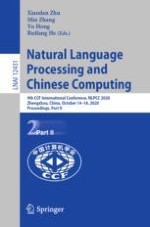2020 | Buch
Natural Language Processing and Chinese Computing
9th CCF International Conference, NLPCC 2020, Zhengzhou, China, October 14–18, 2020, Proceedings, Part II
herausgegeben von: Xiaodan Zhu, Min Zhang, Yu Hong, Ruifang He
Verlag: Springer International Publishing
Buchreihe : Lecture Notes in Computer Science
